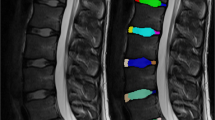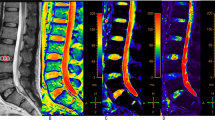Abstract
Purpose
To evaluate the discal morpho-structural changes as predictive sign in the clinical outcome after Ozone Therapy in lumbar disc herniation using the T2 shine-through effect in DWI.
Methods
One hundred and fifty-four patients suffering from lumbosciatica (89 men and 65 women; range 23–62 years) were included in previous MR study performed with FSE-T2 and T2-fat, SE-T1 and DWI sequences and were randomly assigned to two groups. Seventy-seven patients (Control Group) underwent conservative treatment with intraforaminal injection of steroid and anesthetic. The remaining 77 patients (Study Group) underwent the same treatment with the addiction of oxygen–ozone (O2–O3). During the coming 6 months, an MRI follow-up with the same sequences was performed. An intervertebral disc volumetric analysis (IDVA), DWI signal score and post treatment clinical outcome evaluation were performed for an assessment of hernia reduction. χ 2 test, Student’s t test and analysis of covariance were used for comparison of variables.
Results
In the Study Group, 58 over 77 patients had a successful outcome (Responders). In the Responders group, DWI T2 shine-through effect was present during MRI follow-up and in particular in 53 of 77 patients in the 6 months of follow-up (P < 0.05). Moreover, in the same group was present a statistically significant discs’ shrinkage in the sixth month of follow-up (P < 0.05) as showed by IDVA.
Conclusions
T2 shine-through effect in DWI is present before morphological disc reduction and moreover could be considered as a predictive sign of response to oxygen–ozone treatment.







Similar content being viewed by others
References
Andersson GBJ (1997) The epidemiology of spinal disorders. In: Frymoyer JW (ed) The adult spine: principles and practice, 2nd edn. Lippincott-Raven, Philadelphia, pp 93–141
Splendiani A, Ferrari F, Barile A, Masciocchi C, Gallucci M (2014) Occult neural foraminal stenosis caused by association between disc degeneration and facet joint osteoarthritis: demonstration with dedicated upright MRI system. Radiol Med. 119(3):164–174
Barile A, Limbucci N, Splendiani A, Gallucci M, Masciocchi C (2007) Spinal injury in sport. Eur J Radiol 62(1): 68–78
Richard A. Deyo MPH, James N, Weinstein DO (2001) N Engl J Med 344: 363–370
Deyo RA (1986) Early diagnostic evaluation of low back pain. J Gen Intern Med 1:328–338
Deyo RA,Rainville J, Kent DL (1992) What can the history and physical examination tell us about low back pain? JAMA 268: 760–765
Gallucci M, Limbucci N, Paonessa A, Splendiani A (2007) Degenerative disease of the spine. Neuroimaging Clin N Am 17(1): 87–103
Bozzao A, Gallucci M, Masciocchi C et al (1992) Lumbar disk herniation: MR imaging assessment of natural history in patients treated without surgery. Radiology 185:135–141
Guarnieri G, Vassallo P, Pezzullo MG, Laghi F, Zeccolini G, Ambrosanio G, Galasso R, Muto M, Izzo R (2009) A comparison of minimally invasive techniques in percutaneous treatment of lumbar herniated discs. Neuroradiol J 22: 108–121
Andreula CF, Simonetti L, Leonardi M (2003) Minimally invasive oxygen-ozone therapy for lumbar disk herniation. Am J Neuroradiol 24:996–1000
Iliakis E, Valadakis V, Vynios DH, Tisiganos CP, Agapitos E (2001) Rationalization of the activity of medical ozone on intervertebral disc: a histological and biochemical study. Riv Neuroradiol 14(suppl 1):23–30
Muto M (2004) Intradiscal and intramuscular injection of oxygen-ozone: pathological evaluation. work in progress. Riv Italiana di Ossigeno-Ozooterapia 3: 7–13
Iliakis E (1995) Ozone treatment in low back pain. Orthopaedics 1:29–33
Splendiani A, Perri M, Conchiglia A, Fasano F, Di Egidio G, Masciocchi C, Gallucci M (2013) MR assessment of lumbar disk herniation treated with oxygen-ozone diskolysis: the role of DWI and related ADC versus Intervertebral disk volumetric analysis for detecting treatment response. Neuroradiol J 26:347–356
Splendiani A, Puglielli E, De Amicis R, Barile A, Masciocchi C, Gallucci M (2004) Spontaneous resolution of lumbar disk herniation: predictive signs for prognostic evaluation. Neuroradiology 46(11):916–922
Lee JS, Hobden E, Stiell IG, Wells GA (2003) Clinically important change in the visual analog scale after adequate pain control. Acad Emerg Med 10(10):1128–1130
Holder CA, Muthupillai R, Mukundan S, Eastwood JD, Hudgins PA (2000) Diffusion weighted MR imaging of the normal human spinal cord in vivo. AJNR Am J Neuroradiol 21:1799–1806
Kurunlahti M, Jauhiainen J, Karppinen J, Tervonen O (2001) Correlation of diffusion in lumbar intervertebral discs with occlusion of lumbar arteries: a study in adult volunteers. Radiology 221:779–786
Kerttula L, Jauhiainen J, Koivula A, Oikarinen J, Tervonen O (2001) Apparent diffusion coefficients and T2 relaxation time measurements to evaluate disc degeneration: a quantitative MR study of young patients with previous vertebral fracture. Acta Radiol 42:585–591
Fardon DF, Milette PC (2001) Nomenclature and classification of lumbar disc pathology. Recommendations of the combined task forces of the north american spine society, American society of spine radiology, and american society of neuroradiology. Spine 26:E93–E113
Landis RJ, Koch GG (1977) The measurement of observer agreement for categorical data. Biometrics 33:159–174
Bammer R. Herneth AM. Maier SE (2003) Line scan diffusion imaging of the spine. AJNR Am J Neuroradiol 24: 5–12
Hsu EW, Setton LA (1999) Diffusion tensor microscopy of the intervertebral disc annulus fibrosus. Magn Reson Med 41:992–999
Conflict of interest
The authors declare no conflict of interest.
Ethical standards
This article contains research involving Human participitants. We obtained informed consent from all participants. No Animals are involved in this study.
Author information
Authors and Affiliations
Corresponding author
Rights and permissions
About this article
Cite this article
Perri, M., Grattacaso, G., di Tunno, V. et al. T2 shine-through phenomena in diffusion-weighted MR imaging of lumbar discs after oxygen–ozone discolysis: a randomized, double-blind trial with steroid and O2–O3 discolysis versus steroid only. Radiol med 120, 941–950 (2015). https://doi.org/10.1007/s11547-015-0519-z
Received:
Accepted:
Published:
Issue Date:
DOI: https://doi.org/10.1007/s11547-015-0519-z




